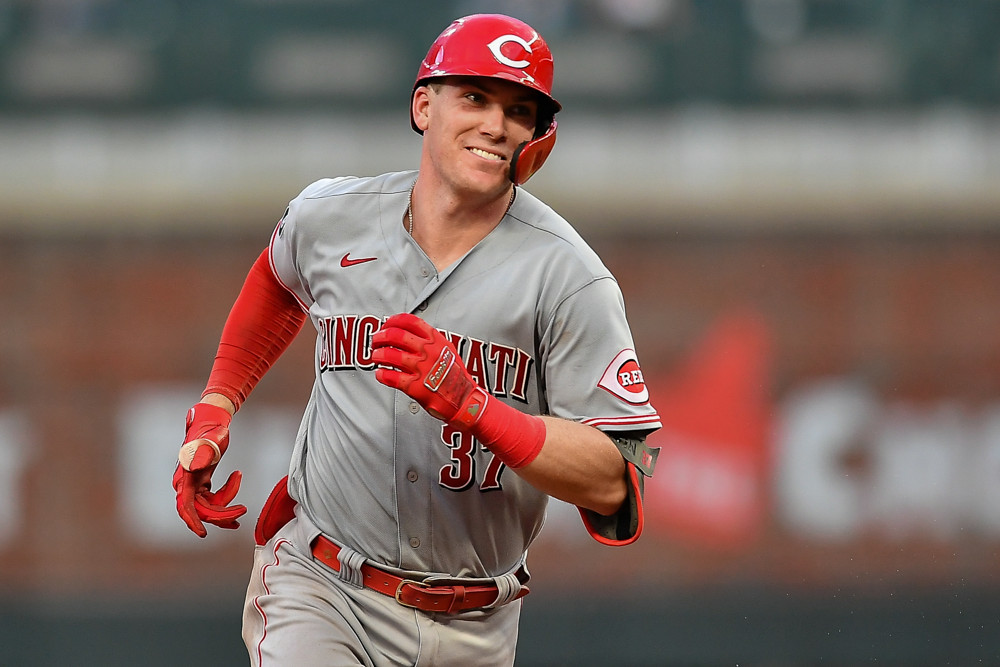
Baseball is a cruel sport. Tyler Stephenson started the 2023 season in the cleanup spot, hot on the heels of an injury-plagued but productive year in 2022. That season, Stephenson slashed a nifty .319/.372/.482, good for a 135 wRC+, meaning he hit 35% better than league average. Those numbers came in only 183 plate appearances and were buoyed by an otherworldly .409 batting average on balls in play (BABIP), but it was enough for the Reds to add first base and designated hitter to his workload to try and keep him in the lineup regularly.
Then 2023 happened. Stephenson never hit a groove, struggling for much of the year both offensively and defensively. His OPS dropped from .854 to sub .700, and according Fangraphs, he was below a replacement level player.
Yikes.
Coming into 2024, it was fair to question whether Stephenson should be the number one catcher; he had gone from indispensable to borderline unplayable. For a 27-year-old, that’s quite a wild ride.
But Stephenson never lost faith in his ability. As reported by Mark Sheldon, the young catcher put work in the offseason to become “one of the best catchers in baseball.” While his current slash line wouldn’t suggest it, Stephenson has improved in myriad of ways thus far this year at the plate and behind it. In this piece, we’ll focus on his development with the bat. Here’s a snapshot of his 2023 versus 2024:

Stephenson 2023

Stephenson 2024
Woah. Quite a change. As a hitter, Stephenson has improved in almost every category. I want to highlight a few things that have seemingly made the biggest difference.
Plate Discipline
In 2021, Stephenson’s first full season, he rarely swung and missed, at least by baseball standards. His 19.2% whiff percentage was well above average. Borderline elite. That changed the last two seasons, and in 2023, he was in the bottom third of the league. This year, he’s closed the hole in his bat, making much more contact both in and out of the zone:

Stephenson is swinging at fewer pitches than he ever has, but that selectiveness has aided him in increased contact. A lot of this improvement comes from hitting fastballs more often. He’s only missed 10.5% of the fastballs he’s swung at, down from almost 24% last season. That’s led to fewer strikeouts (26.1% to 22.9% in K%) and more walks (9.1% to 12.9% in BB%). In these ways, he’s much closer to the rookie season version than the guy we saw the last two years. But in one significant way, he has grown beyond the player he has ever been in the past.
Quality of Contact
Stephenson is a big man, large enough (6-foot-4, 225 pounds) that you might profile him as an Adam Dunn type: a man who makes LOUD contact whenever contact is made. To this point in his career, Stephenson hasn’t come close to being that guy. Last season, he made the best contact of his career, and it was still roughly league average. His reputation as someone who tried to flare the ball the other way may be overstated, but he certainly wasn’t hitting the ball with authority. All that has changed dramatically.

Only Shohei Ohtani has a higher barrel percentage than Stephenson and only eight players across all of baseball have a higher hard-hit percentage. He’s not just making good contact; he’s making elite contact. Those fastballs he’s no longer missing? Those are getting hammered (92.4 exit velocity). All three of his home runs have come on fastballs, and his expected slugging percentage based on that quality of contact is .575. That’s big time power from the formally gentle giant.
Lagging Results
Thus far, the results haven’t lined up with how well Stephenson is performing at the plate. There are significant gaps between what we’d expect his numbers to be and what they actually are.

Essentially, Stephenson’s performance has been hampered by misfortune (.238 BABIP). If he continues to make the amount and quality of contact he has thus far, we should expect him to find more gaps and hit more baseballs out of the ballpark. Recently, we’ve seen that tide begin to turn. David Bell has clearly taken notice, moving Stephenson up in the lineup against both left-handers and right-handers.
Conclusion
After a tough 2023, Tyler Stephenson has seemingly turned a corner this year. It remains to be seen whether he can continue this pace or something like it, but the former first-round pick could be reaching the potential we hoped for after a solid rookie campaign. For a team who needs multiple young players to take a step forward if they want to contend, Stephenson’s emergence is a crucial development. Here’s hoping for more of this.
Featured Image: Rich von Biberstein/Icon Sportswire


